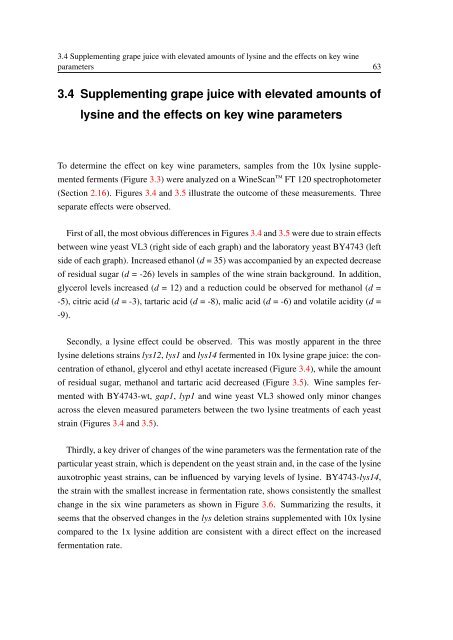Identification of yeast genes involved in Sauvignon Blanc aroma ...
Identification of yeast genes involved in Sauvignon Blanc aroma ...
Identification of yeast genes involved in Sauvignon Blanc aroma ...
Create successful ePaper yourself
Turn your PDF publications into a flip-book with our unique Google optimized e-Paper software.
3.4 Supplement<strong>in</strong>g grape juice with elevated amounts <strong>of</strong> lys<strong>in</strong>e and the effects on key w<strong>in</strong>eparameters 633.4 Supplement<strong>in</strong>g grape juice with elevated amounts <strong>of</strong>lys<strong>in</strong>e and the effects on key w<strong>in</strong>e parametersTo determ<strong>in</strong>e the effect on key w<strong>in</strong>e parameters, samples from the 10x lys<strong>in</strong>e supplementedferments (Figure 3.3) were analyzed on a W<strong>in</strong>eScan FT 120 spectrophotometer(Section 2.16). Figures 3.4 and 3.5 illustrate the outcome <strong>of</strong> these measurements. Threeseparate effects were observed.First <strong>of</strong> all, the most obvious differences <strong>in</strong> Figures 3.4 and 3.5 were due to stra<strong>in</strong> effectsbetween w<strong>in</strong>e <strong>yeast</strong> VL3 (right side <strong>of</strong> each graph) and the laboratory <strong>yeast</strong> BY4743 (leftside <strong>of</strong> each graph). Increased ethanol (d = 35) was accompanied by an expected decrease<strong>of</strong> residual sugar (d = -26) levels <strong>in</strong> samples <strong>of</strong> the w<strong>in</strong>e stra<strong>in</strong> background. In addition,glycerol levels <strong>in</strong>creased (d = 12) and a reduction could be observed for methanol (d =-5), citric acid (d = -3), tartaric acid (d = -8), malic acid (d = -6) and volatile acidity (d =-9).Secondly, a lys<strong>in</strong>e effect could be observed. This was mostly apparent <strong>in</strong> the threelys<strong>in</strong>e deletions stra<strong>in</strong>s lys12, lys1 and lys14 fermented <strong>in</strong> 10x lys<strong>in</strong>e grape juice: the concentration<strong>of</strong> ethanol, glycerol and ethyl acetate <strong>in</strong>creased (Figure 3.4), while the amount<strong>of</strong> residual sugar, methanol and tartaric acid decreased (Figure 3.5). W<strong>in</strong>e samples fermentedwith BY4743-wt, gap1, lyp1 and w<strong>in</strong>e <strong>yeast</strong> VL3 showed only m<strong>in</strong>or changesacross the eleven measured parameters between the two lys<strong>in</strong>e treatments <strong>of</strong> each <strong>yeast</strong>stra<strong>in</strong> (Figures 3.4 and 3.5).Thirdly, a key driver <strong>of</strong> changes <strong>of</strong> the w<strong>in</strong>e parameters was the fermentation rate <strong>of</strong> theparticular <strong>yeast</strong> stra<strong>in</strong>, which is dependent on the <strong>yeast</strong> stra<strong>in</strong> and, <strong>in</strong> the case <strong>of</strong> the lys<strong>in</strong>eauxotrophic <strong>yeast</strong> stra<strong>in</strong>s, can be <strong>in</strong>fluenced by vary<strong>in</strong>g levels <strong>of</strong> lys<strong>in</strong>e. BY4743-lys14,the stra<strong>in</strong> with the smallest <strong>in</strong>crease <strong>in</strong> fermentation rate, shows consistently the smallestchange <strong>in</strong> the six w<strong>in</strong>e parameters as shown <strong>in</strong> Figure 3.6. Summariz<strong>in</strong>g the results, itseems that the observed changes <strong>in</strong> the lys deletion stra<strong>in</strong>s supplemented with 10x lys<strong>in</strong>ecompared to the 1x lys<strong>in</strong>e addition are consistent with a direct effect on the <strong>in</strong>creasedfermentation rate.














